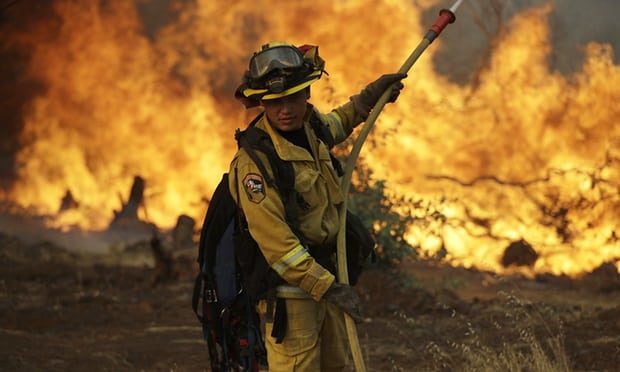
There are now 12,000 firefighters on the lines battling 17 large wildfires, which have destroyed more than 1,000 structures and continue to threaten an additional 25,000 homes, according to the California Department of Forestry and Fire Protection, known as Cal Fire. At least eight deaths have been attributed to the fires, which have burned about almost 240,000 acres, or about 375 square miles up and down the state.
"We're very active right now across the state with fires," said Cal Fire Deputy Chief Scott McLean. "Vegetation is so dry, especially with the winds that are coming and have been coming."
Cal Fire said Monday that hot and dry conditions have contributed to the wildfire risk statewide, including low humidity and high winds in some areas of Northern California. The southern portion of the state has baked in triple-digit temperatures in some inland areas in recent weeks.
Adding to the wildfire risk are an estimated 129 million dead trees in California forests due to years of drought and beetle infestation, according to the U.S. Forest Service.
More than 52,000 residents have been evacuated in the large fires, according to Cal Fire.
The most destructive blaze is the so-called Carr fire in Shasta and Trinity counties, which has destroyed at least 818 homes and killed six people. As of Monday evening, the fire has burned nearly 104,000 acres and was listed as 23 percent contained and with more than 3,600 fire personnel on the lines.
The state called in California National Guard troops to assist in firefighting efforts, but McLean said resources are still "tight" with so many major fires burning statewide. By the end of the week, California expects to have crews from more than a dozen other states on the fire lines helping to battle the blazes, with new arrivals coming from Florida, Michigan, New Jersey, Maryland, New Mexico and Oregon.
California already has spent $115 million on emergency firefighting since the start of the July 1 fiscal year, or about one-fourth of the state's $442.8 million annual so-called e-fund budget, according to H.D. Palmer, a spokesman for the California Department of Finance. Those fire costs are through Friday and expected to go up due to extensive ground and air firefighting resources being used.
However, if the state's fire costs exceed its e-fund budget in fiscal 2018-19, California can tap into its traditional budget reserves. California's state budget reserves now total about $2 billion.
In Northern California, crews were making progress in fighting the Carr fire, which started a week ago. Officials believe the fire was ignited by mechanical failure of a vehicle.
"The fire perimeter in Redding itself is now contained," said Jonathan Cox, a regional battalion chief with Cal Fire in Northern California. "So now we're just literally trying to secure all of the areas so we can get people home."
Authorities on Sunday announced a sixth fatality for the Carr fire, which forced about 38,000 residents to evacuate last week. Shasta Sheriff Tom Bosenko announced Monday afternoon there are 19 reports outstanding of missing person cases.
Fire personnel are now focusing on getting in front of the Carr fire on the Trinity County side using bulldozers and hand crews. Cox said the monster fire is now burning in sparsely populated areas; as of Monday temperatures had fallen about 10 degrees from last week's peak and there was little or no wind.
About 150 miles to the south, there are two other major wildfires burning in Mendocino and Lake counties. As of Monday afternoon the Ranch fire had burned more than 45,000 acres and the River fire 23,411 acres. Thousands of people were evacuated from mostly rural areas and some small towns in the path of the fires, which remain under investigation. The two blazes are 5 percent contained.
The Ferguson fire in Mariposa County, now in its 19th day, has burned more than 57,000 acres and forced the closure of Yosemite National Park. Officials said they plan to reopen Yosemite park to all visitors starting Friday afternoon.
There have been two fire personnel fatalities in connection with the Ferguson fire, including a firefighter who died Saturday in the line of duty when he was struck by a tree. As of Monday, the blaze was 30 percent contained and had more than 3,600 fire personnel engaged on the fire. The cause of the blaze is still listed as unknown.
Further south, the Cranston fire is burning near Idyllwild in Riverside County. It has charred more than 13,100 acres and is 57 percent contained. There are more than 1,500 crews battling the arson-sparked fire, which has charred brush and timber in the San Jacinto Mountains.



Comment: Deadly wildfires blaze across California amid fears that 'the worst is yet to come'